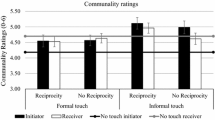Abstract
According to a social meaning model of nonverbal communication, many nonverbal behaviors have consensually recognized meanings. Two field experiments examined this presumption by investigating the relational message interpretations assigned to differing levels and types of touch, proximity, and posture. Also examined were the possible moderating effects of the communicator characteristics of gender and attractiveness and relationship characteristics of gender composition and status differentials. Results showed that touching typically conveyed more composure, immediacy, receptivity/trust, affection, similarity/depth/equality, dominance, and informality than its absence. The form of touch also mattered, with handholding and face touching expressing the most intimacy, composure, and informality; handholding and the handshake expressing the least dominance, and the handshake conveying the most formality but also receptivity/trust. Postural openness/relaxation paralleled touch in conveying greater intimacy, composure, informality, and similarity but was also less dominant than a closed/tense posture. Close proximity was also more immediate and similar but dominant. Proximity and postural openness together produced differential interpretations of composure, similarity, and affection. Gender initiator attractiveness was more influential than status in moderating interpretations.
Similar content being viewed by others
References
Abele, A. (1986). Functions of gaze in social interaction: Communication and monitoring.Journal of Nonverbal Behavior, 10, 83–101.
Baglan, T., & Nelson, D. J. (1982). A comparison of the effects of sex and status on the perceived appropriateness of nonverbal behaviors.Women's Studies in Communication, 5, 29–38.
Breed, G., & Ricci, J. S. (1973). “Touch me, like me”: Artifact?Proceedings of the 81st Annual Convention of the American Psychological Association, 8, 153–154.
Burgoon, J. K. (1980). Nonverbal communication research in the 1970s: An overview. In D. Nimmo (Ed.),Communication yearbook 4 (pp. 179–197). New Brunswick, NJ: Transaction Books.
Burgoon, J. K., Buller, D. B., Hale, J. L., & deTurck, M. A. (1984). Relational messages associated with nonverbal behaviors.Human Communication Research, 10, 351–378.
Burgoon, J. K., Buller, D. B., & Woodall, W. G. (1989).Nonverbal communication: The unspoken dialogue. New York: Harper & Row.
Burgoon, J. K., Coker, D. A., & Coker, R. A. (1986). Communicative effects of gaze behavior: A test of two contrasting explanations.Human Communication Research, 12, 495–524.
Burgoon, J. K., & Hale, J. L. (1984). The fundamental topoi of relational communication.Communication Monographs, 51, 193–214.
Burgoon, J. K., & Hale, J. L. (1987). Validation and measurement of the fundamental themes of relational communication.Communication Monographs, 54, 19–41.
Burgoon, J. K., & Hale, J. L. (1988). Nonverbal expectancy violations theory: Model elaboration and application to immediacy behaviors.Communication Monographs, 55, 58–79.
Burgoon, J. K., & Newton, D. A. (1991). Applying a social meaning model to relational message interpretations of conversational involvement: Comparing observer and participant perspectives.Southern Communication Journal, 56, 96–113.
Burgoon, J. K., Newton, D. A., Walther, J. B., & Baesler, E. J. (1989). Nonverbal expectancy violations and conversational involvement.Journal of Nonverbal Behavior, 13, 97–120.
Burgoon, J. K., & Walther, J. B. (1990). Nonverbal expectancies and evaluative consequences of violations.Human Communication Research, 17, 232–265.
Derlega, V., Lewis, R. J., Harrison, S., Winstead, B. A., & Costanza, R. (1989). Gender differences in the initiation and attribution of tactile intimacy.Journal of Nonverbal Behavior, 13, 83–96.
Ellsworth, P. C., & Ludwig, L. M. (1972). Visual behavior in social interactions.Journal of Communication, 22, 375–403.
Givens, D. B. (1978). The nonverbal basis of attraction: Flirtation, courtship, and seduction.Psychiatry, 41, 346–359.
Henley, N. M., & Harmon, S. (1985). The nonverbal semantics of power and gender: A perceptual study. In S. L. Ellyson & J. F. Dovidio (Eds.),Power, dominance. and nonverbal behavior (pp. 151–164). New York: Springer-Verlag.
Huberty, C. J., & Morris, J. D. (1989). Multivariate analysis versus multiple univariate analyses.Psychological Bulletin, 105, 302–308.
Kleinke, C. L., Meeker, F. B., & LaFong, C. (1974). Effects of gaze, touch, and use of name on evaluation of “engaged” couples.Journal of Research in Personality, 7, 368–373.
Jones, S. E., & Yarbrough, A. E. (1985). A naturalistic study of the meanings of touch.Communication Monographs, 52, 19–56.
Klockars, A. J., & Sax, G. (1986).Multiple comparisons. Beverly Hills, CA: Sage.
Major, B., & Heslin, R. (1982). Perceptions of cross-sex and same-sex nonreciprocal touch: It is better to give than to receive.Journal of Nonverbal Behavior, 6, 148–162.
Mehrabian, A. (1967). Orientation behaviors and nonverbal attitude communication.Journal of Communication, 17, 324–332.
Mehrabian, A. (1968a). Inference of attitude from the posture, orientation, and distance of a communicator.Journal of Consulting and Clinical Psychology, 32, 296–308.
Mehrabian, A. (1968b). Relationship of attitude to seated posture, orientation, and distance.Journal of Personality and Social Psychology, 10, 26–30.
Mehrabian, A. (1969). Significance of posture and position in the communication of attitude and status relationships.Psychological Bulletin, 71, 357–372.
Mehrabian, A. (1970). A semantic space for nonverbal behavior.Journal of Consulting and Clinical Psychology, 35, 248–257.
Mehrabian, A. (1981).Silent messages: Implicit communication of emotions and attitudes (2nd ed.). Belmont, CA: Wadsworth.
Mehrabian, A., & Ksionzky, S. (1972). Categories of social behavior.Comparative Group Studies, 3, 425–436.
Mehrabian, A., & Williams, M. (1969) Nonverbal concomitants of perceived and intended persuasiveness.Journal of Personality and Social Psychology, 13, 37–58.
Sabatelli, R. M., & Rubin, M. (1986). Nonverbal expressiveness and physical attractiveness as mediators of interpersonal perceptions.Journal of Nonverbal Behavior, 10, 120–133.
Trout, D. L., & Rosenfeld, H. M. (1980). The effect of postural lean and body congruence on the judgment of psychotherapeutic rapport.Journal of Nonverbal Behavior, 4, 176–190.
Watzlawick, P., Beavin, J. H., & Jackson, D. D. (1967).Pragmatics of human communication: A study of interactional patterns, pathologies, and paradoxes. New York: W. W. Norton.
Author information
Authors and Affiliations
Additional information
An earlier version of this paper was presented to the Interpersonal Communication Interest Group, Western States Communication Association convention, Phoenix, Arizona, February 1991. The author wishes to thank Leesa Dillman for her assistance on that version.
Rights and permissions
About this article
Cite this article
Burgoon, J.K. Relational message interpretations of touch, conversational distance, and posture. J Nonverbal Behav 15, 233–259 (1991). https://doi.org/10.1007/BF00986924
Issue Date:
DOI: https://doi.org/10.1007/BF00986924



